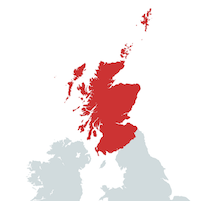
Map by mapchart.net - Some rights reserved.
Location
Stirling, Stirling, Scotland
Description
Stirling Castle is situated on top of atop the Castle Hill in Stirling. It is one of the largest and most significant castles in Scotland. The site is surrounded on three sides by steep cliffs and was strategically positioned to guard the crossing of the River Forth.
There is a gatehouse providing entry from the outer defences to the Castle that originally extended across the whole width of the Rock. At either end were rectangular blockhouses, and in the centre, flanking the gateway, were four round towers with conical roofs. Of these structures round the entrance, still standing today is the southern blockhouse (the Prince's Tower), the adjoining curtain wall, the gateway and lower portion of the inner towers, and parts of the outer towers, and parts of the northern blockhouse. To the left of the gatehouse is the impressive Palace block with a mixture of renaissance and gothic detail. The ceiling of the King's Presence Chamber was originally decorated with famous portrait roundels known as The Stirling Heads. These were removed in 1777, and some are preserved in the castle and some in other museums. Beyond the Palace block is the Great Hall.
The Castle is a Scheduled Ancient Monument, and is now managed by Historic Scotland. The castle is open to the public and has a Cafe and shops available for visitors. The regimental museum of the Argyll and Sutherland Highlanders is located within the castle.
History
There has been a castle on the site since the 12th century. Most of the current buildings of the Castle date from the late 15th and 16th centuries and were built between 1496 and 1583. The castle was home to Scottish Kings and Queens from the days of Alexander I, through James IV, James V, until the Union of the Crowns under James VI. Numerous Scottish Kings and Queens have been crowned at Stirling, including Mary, Queen of Scots, in 1543. The castle outer defences were built in the early 18th century. In 1746, Charles Edward Stuart, "Bonnie Prince Charlie", and his Jacobite force unsuccessfully tried to take the castle.
From 1800 until 1964, Stirling Castle was owned by the British Army and used as a barracks. During that time, many alterations were made - the Great Hall became an accommodation block; the Chapel Royal became a lecture theatre and dining hall; the King's Old Building became an infirmary; the Royal Palace became the Officer's Mess. These buildings are now being restored to their original state. Some new buildings were also constructed, including the prison and powder magazine in 1810. Stirling Castle is still the headquarters of the Argyll and Sutherland Highlanders, although the regiment is no longer garrisoned there.
The Arts
The Castle esplanade has been used as an open-air concert venue for several acts including R.E.M., Bob Dylan, Wet Wet Wet, and Runrig.
Other Castles in the Area
Airth Castle, Falkirk
Bedlay Castle, Lanarkshire
Castle Campbell, Clackmannanshire
Craigend Castle, East Dunbartonshire
Culcreuch Castle, Stirling
Doune Castle, Stirling
Drummond Castle, Perth and Kinross
Mugdock Castle, Glasgow
Tulliallan Castle, Fife
|
|
|
|

